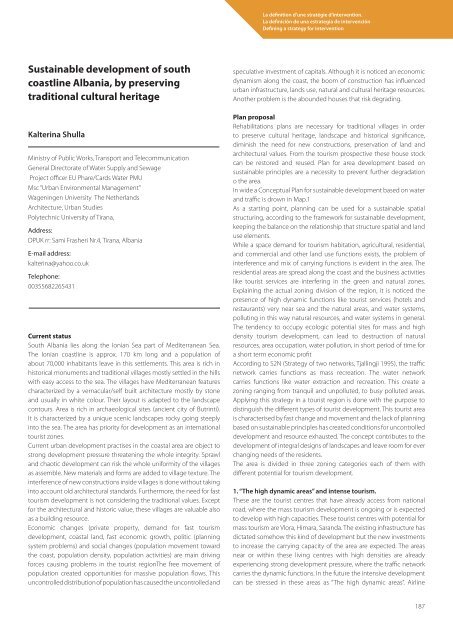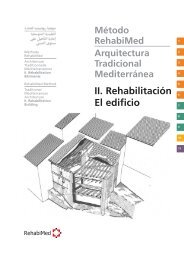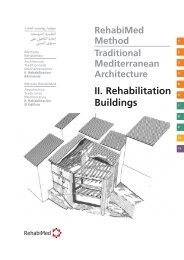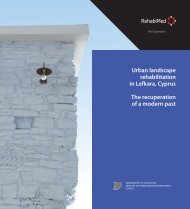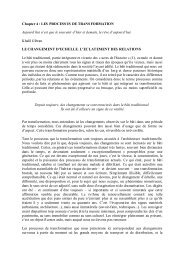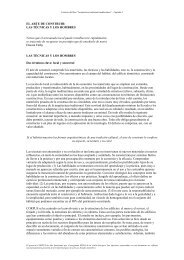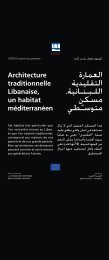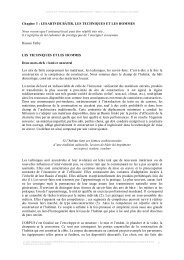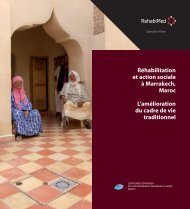La définition d'une stratégie d'intervention. La ... - RehabiMed
La définition d'une stratégie d'intervention. La ... - RehabiMed
La définition d'une stratégie d'intervention. La ... - RehabiMed
Create successful ePaper yourself
Turn your PDF publications into a flip-book with our unique Google optimized e-Paper software.
<strong>La</strong> <strong>définition</strong> d’une <strong>stratégie</strong> d’intervention.<br />
<strong>La</strong> definición de una estrategia de intervención<br />
Defining a strategy for intervention<br />
Sustainable development of south<br />
coastline Albania, by preserving<br />
traditional cultural heritage<br />
Kalterina Shulla<br />
Ministry of Public Works, Transport and Telecommunication<br />
General Directorate of Water Supply and Sewage<br />
Project officer EU Phare/Cards Water PMU<br />
Msc “Urban Environmental Management”<br />
Wageningen University The Netherlands<br />
Architecture, Urban Studies<br />
Polytechnic University of Tirana,<br />
Address:<br />
DPUK rr: Sami Frasheri Nr.4, Tirana, Albania<br />
E-mail address:<br />
kalterina@yahoo.co.uk<br />
Telephone:<br />
00355682265431<br />
Current status<br />
South Albania lies along the Ionian Sea part of Mediterranean Sea.<br />
The Ionian coastline is approx. 170 km long and a population of<br />
about 70,000 inhabitants leave in this settlements. This area is rich in<br />
historical monuments and traditional villages mostly settled in the hills<br />
with easy access to the sea. The villages have Mediterranean features<br />
characterized by a vernacular/self built architecture mostly by stone<br />
and usually in white colour. Their layout is adapted to the landscape<br />
contours. Area is rich in archaeological sites (ancient city of Butrinti).<br />
It is characterized by a unique scenic landscapes rocky going steeply<br />
into the sea. The area has priority for development as an international<br />
tourist zones.<br />
Current urban development practises in the coastal area are object to<br />
strong development pressure threatening the whole integrity. Sprawl<br />
and chaotic development can risk the whole uniformity of the villages<br />
as assemble. New materials and forms are added to village texture. The<br />
interference of new constructions inside villages is done without taking<br />
into account old architectural standards. Furthermore, the need for fast<br />
tourism development is not considering the traditional values. Except<br />
for the architectural and historic value, these villages are valuable also<br />
as a building resource.<br />
Economic changes (private property, demand for fast tourism<br />
development, coastal land, fast economic growth, politic (planning<br />
system problems) and social changes (population movement toward<br />
the coast, population density, population activities) are main driving<br />
forces causing problems in the tourist regionThe free movement of<br />
<br />
uncontrolled distribution of population has caused the uncontrolled and<br />
speculative investment of capitals. Although it is noticed an economic<br />
<br />
urban infrastructure, lands use, natural and cultural heritage resources.<br />
Another problem is the abounded houses that risk degrading.<br />
Plan proposal<br />
Rehabilitations plans are necessary for traditional villages in order<br />
to preserve cultural heritage, landscape and historical significance,<br />
diminish the need for new constructions, preservation of land and<br />
architectural values. From the tourism prospective these house stock<br />
can be restored and reused. Plan for area development based on<br />
sustainable principles are a necessity to prevent further degradation<br />
o the area.<br />
In wide a Conceptual Plan for sustainable development based on water<br />
and traffic is drown in Map.1<br />
As a starting point, planning can be used for a sustainable spatial<br />
structuring, according to the framework for sustainable development,<br />
keeping the balance on the relationship that structure spatial and land<br />
use elements.<br />
While a space demand for tourism habitation, agricultural, residential,<br />
and commercial and other land use functions exists, the problem of<br />
interference and mix of carrying functions is evident in the area. The<br />
residential areas are spread along the coast and the business activities<br />
like tourist services are interfering in the green and natural zones.<br />
Explaining the actual zoning division of the region, it is noticed the<br />
presence of high dynamic functions like tourist services (hotels and<br />
restaurants) very near sea and the natural areas, and water systems,<br />
polluting in this way natural resources, and water systems in general.<br />
The tendency to occupy ecologic potential sites for mass and high<br />
density tourism development, can lead to destruction of natural<br />
resources, area occupation, water pollution, in short period of time for<br />
a short term economic profit<br />
According to S2N (Strategy of two networks, Tjallingji 1995), the traffic<br />
network carries functions as mass recreation. The water network<br />
carries functions like water extraction and recreation. This create a<br />
zoning ranging from tranquil and unpolluted, to busy polluted areas.<br />
Applying this strategy in a tourist region is done with the purpose to<br />
distinguish the different types of tourist development. This tourist area<br />
is characterised by fast change and movement and the lack of planning<br />
based on sustainable principles has created conditions for uncontrolled<br />
development and resource exhausted. The concept contributes to the<br />
development of integral designs of landscapes and leave room for ever<br />
changing needs of the residents.<br />
The area is divided in three zoning categories each of them with<br />
different potential for tourism development.<br />
1. “The high dynamic areas” and intense tourism.<br />
These are the tourist centres that have already access from national<br />
road, where the mass tourism development is ongoing or is expected<br />
to develop with high capacities. These tourist centres with potential for<br />
mass tourism are Vlora, Himara, Saranda. The existing infrastructure has<br />
dictated somehow this kind of development but the new investments<br />
to increase the carrying capacity of the area are expected. The areas<br />
near or within these living centres with high densities are already<br />
experiencing strong development pressure, where the traffic network<br />
carries the dynamic functions. In the future the intensive development<br />
can be stressed in these areas as “The high dynamic areas”. Airline<br />
187


